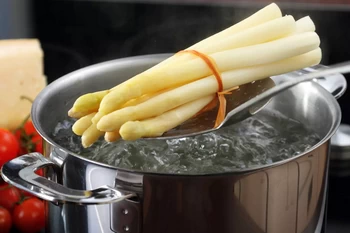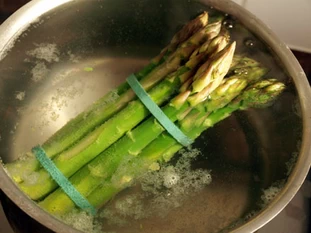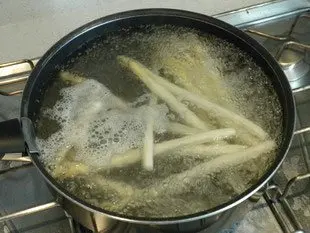This site uses only a few technical cookies necessary for its operation. By continuing to browse, you accept their use.
To find out more...
To find out more...
Should asparagus really be cooked in bunches?

You'll probably read recipes here and there explaining how to cook asparagus "en botte", i.e. in a small package (the famous "botte").
Is this really the right way to cook asparagus?
Is this really the right way to cook asparagus?
7,779 5/5 (1 reviews)
Keywords for this post:AsparagusCookingTipBundleLegendLast modified on: May 22th 2024
Should asparagus really be cooked in bunches?
"Botte" cooking
This is a method familiar to all professional cooks when cooking asparagus: peel the asparagus, tie it together with string or a rubber band to form a small bundle, the "botte", and plunge it into boiling salted water.
Remove the bundle from the water, drain and cut the string.
Is this a good method?
This method seems like a good idea, but it's not. In practice, doing it this way leads to problems with cooking levels.- Bunching the asparagus increases the overall cooking time, with the asparagus around the edges cooking faster than the asparagus in the middle, which takes longer.
- This difference in cooking time means that some asparagus (again, those in the middle) may be overcooked, while those in the middle may be undercooked.
- If you want to check doneness with the tip of a knife, it's almost impossible with the asparagus in the center, unless you go through the asparagus in the middle.


To sum up: don't cook your asparagus in bunches, as they won't cook as evenly as conventional asparagus.
Lasts posts
Butter vs. grease
We often read in a recipe where a pastry is put into a mould that, just before pouring, the mould should be buttered or greased. But what's the difference between these 2 terms?December 1st 20251,0015
Getting out of the fridge early
Very often when you're cooking, you need to take food or preparations out of the fridge, to use them in the recipe in progress. There's nothing tricky about this: you just take them out of the fridge and use them, usually immediately, in the recipe. But is this really a good method?November 24th 20251,1305
Who's making the croissants?
When you look at a bakery from the outside, you naturally think that in the bakery, the bakers make the bread, and in the laboratory, the pastry chefs make the cakes. It's very often like that, with each of these professions having quite different ways of working, but sometimes there's also one...November 23th 20251,021
Oven height
When we put a dish or cake in the oven, we naturally tend to put it on the middle shelf, and that's what we usually do. But in some cases, this position and height can be a little tricky, so let's find out why.October 8th 20252,7695
The importance of sieving
In recipes that use a fine powder (flour, powdered sugar, etc.), you'll often see the advice to sift before using it. To sift is to pass the powder in question through a sieve (a very fine strainer) before incorporating it into your recipe. It's often advice, but is it really useful?September 3rd 20257,5383
Other pages you may also like
How to zest a fruit?
You will have no doubt noticed that many recipes call for the zest of citrus fruit. The zest is that outer layer of the skin which adds so much flavour to a dish. There are many different ways to peel off the zest and various tools are available. Here is a summary of the “dos and don'ts” of...November 5th 201347 K3.8
Candied fruits: don't get ripped off
Do you like candied fruit? You might like to nibble a handful or add it to a recipe, like a classic fruit cake or delicious Italian specialities like panettone or sicilian epiphany pie.June 21th 201767 K 24.2
The first breads of humanity?
I have already told you in a previous article the beautiful story of the croissants, but do you know what it is about the bread, who "invented" it, where and when? Well, you can imagine that recent discoveries, in 2018, have profoundly changed the history of bread.February 16th 201914 K5
Drawing a pattern in pastry
Often in the kitchen, in pastry-making, or in baking, we need to trace a pattern on a pastry. It's just a question of aesthetics but it has its effect after baking on a galette, pithiviers, pâté en croute (terrine in a pie crust), etc.May 23th 201935 K4.1
Balancing flavours
In the kitchen, we sometimes use ingredients that can be a little overwhelming in taste. Grilled lardons, for example, are very good, they give a great taste to a lot of recipes where they are added, but you have to be objective, they're still pretty fatty!November 7th 20208,8315
Post a comment or question
Follow this page
If you are interested in this page, you can "follow" it, by entering your email address here. You will then receive a notification immediately each time the page is modified or a new comment is added. Please note that you will need to confirm this following.
Note: We'll never share your e-mail address with anyone else.
Alternatively: you can subscribe to the mailing list of cooling-ez.com , you will receive a e-mail for each new recipe published on the site.









